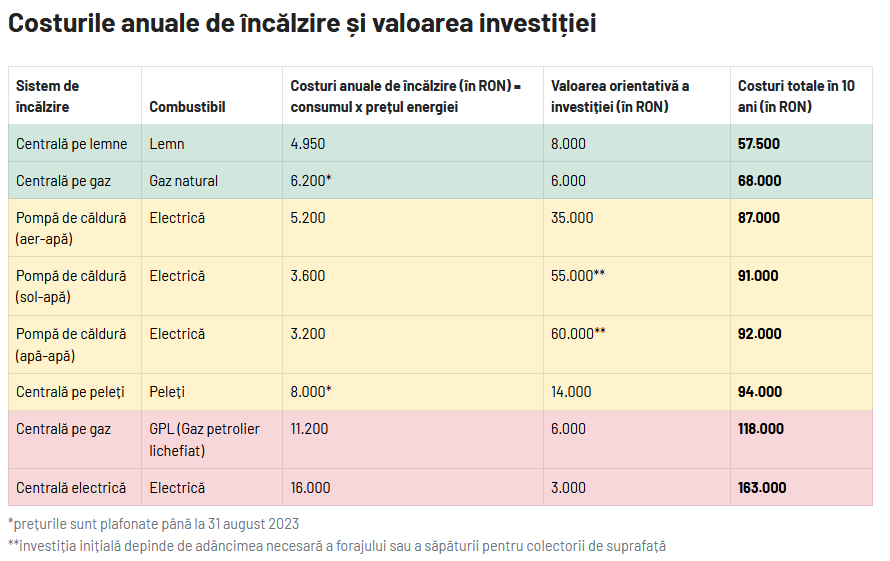
To simplify, when we evaluate the most cost-effective heating system, we only care about two things: how much the monthly heating costs and what is the initial investment in the heating system. A larger investment is only worth it if you manage to save energy in the long run.
When calculating heating costs, it is necessary to take into account energy prices and the efficiency of the heating system. For ease of comparison, it is necessary to bring the prices to a common denominator – the price of useful energy.
Take for example an average single-family house with a heating area of 140 m2. The house has an insulated attic, PVC double-glazed windows and a facade with 8 cm thermal insulation. Let’s assume that the annual energy consumption is 20,000 kWh.
What is the annual cost of heating such a house? Heating system experts from Necesit.ro helped us make the calculations.

The figures are indicative, as the cost of the initial investment can vary significantly from one project to another. In addition, the 10-year calculation does not take into account that heating systems lose efficiency over time, so the annual cost increases gradually.
Wood boiler: the cheapest, but impractical
Wood heating is the cheapest so far, but it is not suitable for all houses. They are the most time-consuming and require storage space. Although they are a source of renewable energy, they are a burden on the environment due to the gases and particles emitted.
Benefits: price, availability, VDE, firewood can be made with your own hands
drawback: heating with firewood is labor-intensive, takes a lot of time, requires storage space, and burdens the environment
Monthly cost of firewood (5 coldest months): 990 RON
Annual cost of firewood: 4950 RON
Total cost for 10 years (investment + annual cost of energy): 57,500 RON
Heat pump: a bigger investment that pays off in the long run
Another method of heating the house is a heat pump. The service life of a heat pump is 25 years, compared to 15 years for a wood, gas or oil installation.
Water-to-water and soil-to-water projects are more complex because underground collectors require a well or trench, so the investment is higher. However, these heat pumps are more efficient and consume much less electricity. Especially if you compare them with a power plant.
Benefits: cost-effective renewable energy source, environmentally friendly, easy to use, does not require energy storage, allows cooling in summer
drawback: high initial investment, lower performance and louder noise in cold winter temperatures
Monthly cost of electricity (fixed rate): 433 RON
Annual cost of electricity: 5200 RON
Total cost for 10 years (investment + annual cost of energy): 87,000 RON
Ashley Bailey is a talented author and journalist known for her writing on trending topics. Currently working at 247 news reel, she brings readers fresh perspectives on current issues. With her well-researched and thought-provoking articles, she captures the zeitgeist and stays ahead of the latest trends. Ashley’s writing is a must-read for anyone interested in staying up-to-date with the latest developments.